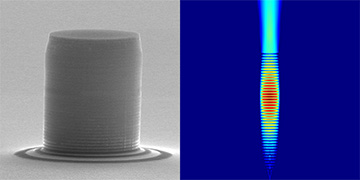
By placing a quantum dot in a Purcell-enhanced micropillar (left), a USTC-led research team has reportedly created a single-photon source with both high quantum efficiency and good single-photon purity and indistinguishability. [Images: (Left) Sven Höfling and Christian Schneider/Universitat Würzburg; (right) Niels Gregersen/Technical University of Denmark]
By embedding a quantum dot inside a resonant micropillar, a multinational team led by scientists from the University of Science and Technology of China (USTC), Shanghai, has created what the researchers say is the first single-photon source that combines “high efficiency and near-perfect levels of purity and indistinguishabilty” (Phys. Rev. Lett., doi: 10.1103/PhysRevLett.116.020401). The team believes that, by providing a better platform for deterministically pumping out a stream of single photons, the approach will prove particularly valuable for multiphoton experiments and certain problems in intermediate quantum computing.
The quest for an ideal source
A device that deterministically emits a stream of “pure” (unbunched) and indistinguishable single photons, one at a time and with high efficiency, has been a holy grail for quantum information for years, and recently numerous research teams have reported substantial progress toward the goal. One especially promising candidate for a deterministic single-photon source is quantum dots, known to output photons with high quantum efficiency.
But using QDs to fashion a single-photon source that’s efficient and still has the required qualities of high photon purity and indistinguishability has proved difficult. That’s because nonresonant excitation of QDs, while great for efficient photon generation, tends to degrade photon purity and indistinguishability. And previous experiments that have excited QDs in resonant cavities, while providing a very pure stream of virtually indistinguishable single photons, have done so at low efficiencies, on the order of 6 percent.
Finding the right micropillar
To break the efficiency-purity conundrum, the USTC-led research team—which also included scientists from the Technical University of Denmark, Universitat Würzburg (Germany), and the University of St. Andrews (U.K.)—focused on building a better resonant cavity. They began by embedding the QD, grown by molecular-beam epitaxy, in a single-wavelength-thick layer of gallium arsenide, sandwiched between stacks of distributed Bragg reflectors (DBRs) made with alternating aluminum arsenide/gallium arsenide mirror pairs. They then used electron beam lithography to carve the stacked structure into a 2.5-μm-diameter micropillar around the embedded dot.
The dimensions and characteristics of the QD-micropillar system were carefully designed to take maximum advantage of the Purcell effect—the enhancement of the QD’s emission rate through matching with the cavity’s resonance. The result: when the scientists used a 897.44-nm Ti:sapphire laser to excite the micropillar-enclosed QD, they were able to generate a stream of some 3.7 million single photons per second—an extraction efficiency of 66 percent, or an order of magnitude greater than previous QD studies using a planar resonant cavity. Yet purity and indistinguishability didn’t suffer; the team reports that the setup resulted in single-photon purity on the order of 99.1 percent, and indistinguishability of 98.5 percent.
The researchers believe that this improved photon source could prove particularly useful in developing a “boson sampling” device—a type of intermediate quantum computer that may be able to solve certain “classically hard” problems faster than conventional computers, but that could be easier to implement than a universal quantum computer.

